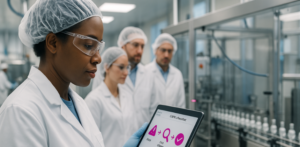GMP (Good Manufacturing Practice)
Definition
Good Manufacturing Practice (GMP) refers to the systems and protocols required to ensure that pharmaceutical products are consistently produced and controlled according to quality standards. GMP is designed to minimize the risks involved in pharmaceutical production that cannot be eliminated through testing the final product alone.
Current Good Manufacturing Practice (cGMP) refers to the most up-to-date regulations enforced by regulatory agencies like the U.S. Food and Drug Administration (FDA), European Medicines Agency (EMA), and others. The “current” in cGMP emphasizes the need for companies to use modern technologies and systems.
Detailed Explanation
Purpose of GMP
The primary purpose of GMP is to safeguard public health by ensuring that pharmaceutical and life science products meet the required safety, quality, and efficacy standards. GMP covers all aspects of production, from the raw materials and equipment to the training and hygiene of staff.
Core Principles of GMP
- Manufacturing processes are clearly defined and controlled.
- Procedures are written in clear language and followed precisely.
- Operators are trained to carry out and document procedures.
- Records are made during manufacture to show all steps were followed.
- Deviations are investigated and documented.
- Facilities are designed to minimize cross-contamination and errors.
- Quality control is involved in every step of production.
Importance in the Pharmaceutical and Life Sciences Industries
GMP is critical in the pharmaceutical and life sciences industries because it ensures that products are safe for human use. Regulatory compliance with GMP is mandatory for obtaining and maintaining licenses to manufacture and distribute drugs and biologics.
Without GMP, companies risk producing substandard or contaminated products, which can lead to serious health risks, product recalls, regulatory fines, and loss of public trust.
Application Areas
GMP applies to a variety of sectors within the life sciences, including:
- Pharmaceutical Manufacturing: Ensures drug products are consistently produced and controlled.
- Biotechnology: Applies to biologics and gene therapies requiring sterile processing environments.
- Medical Devices: Manufacturing processes must comply with GMP to ensure device safety and performance.
- Cosmetics and Food Industries: In some jurisdictions, GMP principles are also applied to ensure product safety and quality.
Examples of GMP in Practice
- Cleanroom Protocols: Sterile environments are required for injectable drug production to prevent contamination.
- Batch Records: Every batch of drug must have a detailed record of materials, processes, and personnel involved.
- Equipment Calibration: Instruments used in manufacturing must be regularly calibrated and maintained.
- Quality Audits: Internal and external audits ensure ongoing compliance with GMP standards.
cGMP vs. GMP
While GMP refers to the general practices, cGMP (Current Good Manufacturing Practice) emphasizes the need to keep systems and technologies up to date. Regulatory bodies expect companies to stay current with technological advances and evolving industry standards. For example, automated systems for data management and real-time monitoring are now considered best practices under cGMP.
Regulatory Agencies Enforcing GMP
Several global regulatory bodies enforce GMP guidelines, including:
- U.S. Food and Drug Administration (FDA)
- European Medicines Agency (EMA)
- World Health Organization (WHO)
- Pharmaceuticals and Medical Devices Agency (PMDA – Japan)


